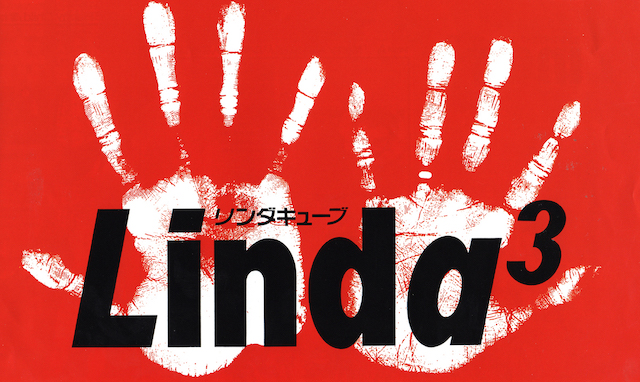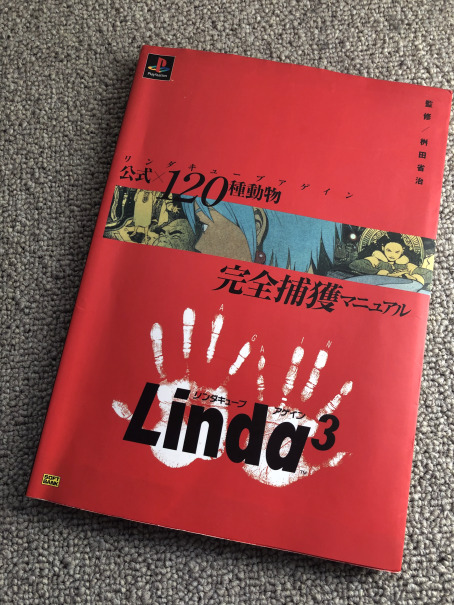Introduction

Hello everyone and welcome to this playthrough of Linda³ ("Linda Cube"), a weird and wonderful game unlike any other!
What is this game, anyway?
Well, on the surface, it's just another 1990s JRPG, although this time with more of a Sci-Fi slant. However, this one has, over time, achieved a bit of a "cult classic" status, due to some of its plot elements and the overall execution.
A bit of history. The game, directed by Shoji Masuda, was released originally on PC Engine platform in 1995 as a Japan-only release (also worth noting is that 1995 was way at the tail end of that platform's lifecycle, it had pretty much already been discontinued by then!). It then two years later, in 1997, received a remake on PlayStation 1, under the name Linda³ Again. This really was a full on remake: the in-game graphics were much improved, and the original's semi-static cutscenes were replaced by fully animated anime FMVs, in addition to some QOL improvements in the gameplay. Unfortunately, due to Sony's policies at the time, it also received "toning-down" of some of the more violent and/or weird content--the PC Engine original was one of the few 18 rated games on that platform--however, the plot remained largely unchanged. There were also some new extras added to the game (which I will not spoil here).
Apparently, the game was popular enough to then receive also a Sega Saturn port in 1998, this time under the name Linda³ Complete Version! The "Complete" moniker refers to the fact that this version includes even a few more extras, and I think it also came with a soundtrack CD, featuring some music and songs (yes!) from the game's soundtrack. There seems to be what I think is a bit of a misconception, that this version restored things which were toned down for PS1 edition, but as far as I can tell, this is not really the case--rather, this version is, at least when graphics (including the anime cutscenes) and gameplay is concerned, largely the same as the PS1 version. Therefore, if there are any differences, they might be in some restored bits of dialogue or something like that. So I will refer to both PS1 and Saturn versions collectively as "the remake".
In any case, the PS1 version is definitely the most popular one, so that's the version we are going to be playing in this thread.
Uh, but what is it ABOUT?
Right, I got distracted there a bit talking about the game's history. Anyway, to start with, here's a story from the first pages of the manual, which set up the background of the game's plot:
quote:
Even in the old records, no information remained about "mother" Earth, other than the fact that it "became extinct". In the present day, humanity has spread across many planets, so that even the coordinates of the original Earth had been lost to history. In order to find other viable stars and planets, the humankind had to do everything they could to keep moving. By the end of the millennium, they built a vast interstellar Federation.
But by that point the human race had also reached an evolutionary dead end. Humanity was on the verge of slowly dying out--year on year the birth rate kept falling while the death rate was rising, and there were also various other ominous events happening with increasing frequency. The Federation government set up a project to investigate the cause, but it yielded no results. The only disappointing conclusion that could be made was that the life-force of humanity had simply run out. To avoid social unrest, this information was not made public and the Federation continued to struggle in secret.
A few hundred years later, a miracle occurred. A space probe discovered an ideal planet. A planet full of life, green and more beautiful than ever. All kinds of beasts, birds, fish and insects were on the planet.
Even more surprisingly, there were indigenous people living on the planet. But who were they really? Their culture, religion and customs were different from that of mankind, but they were biologically almost identical and their language system was very similar to ours. But what was even more interesting was their extraordinary vitality--they possessed physical, healing and reproductive abilities that could not be found in the contemporary human civilisation.
However, the settlement plan of this planet, which was named Neo-Kenya, turned out to have a limit of 100 years from the start. A huge meteorite was on the way to the planet, so large that it could easily destroy it. The settlers were not told that they are guinea pigs for an experiment, nor that their new home would be dead in 100 years.
They first set foot on Neo-Kenya in the year 1900 AMD, 91 years ago from now...
By the way, AMD stands for "After Mother's Death", implying years since the "mother" Earth became extinct. In any case, this is where our game starts, in the Spring of 1991 AMD and concerns the events around our main characters, Ken and his girlfriend Linda (after whom the game is named), as they try to save the animals of the planet which is about to be destroyed. I'm not going to say too much more right now about the story, since the game's opening does a good job of setting up the rest of the premise. But I guess it's a bit like Pokémon
 except it's definitely not intended for kids. (This is a joke. The game is actually not very much like Pokémon at all. But you'll see what I mean.)
except it's definitely not intended for kids. (This is a joke. The game is actually not very much like Pokémon at all. But you'll see what I mean.)The gameplay
From a purely technical side this has the look of a typical "top-down" JRPG from the 1990s with turn based combat akin to Dragon Quest. It features your standard towns, dungeons and towers, like a Final Fantasy game from early 1990s would. However, it does have a fair bit of mechanics which are either different or not really seen in the other JRPGs of the time. It's also one of those games which doesn't feature random encounters, but instead "enemies" are in fact visible on the overworld--there is also a plot related reason for that, which we will learn soon. I will cover different game mechanics (of which there are a fair few) as we encounter them in the game.
About the LP
Well, first of all, the big elephant in the room. As some of you probably know, none of the versions of this game were ever released outside of Japan. Unfortunately, that means there is no official translation, so you'll have to make do with my imperfect one. Neither Japanese nor English is my native language, so it's probably going to be a little rough, but we should be able to follow the plot well enough. I am aware that there has been a fan translation in the works already for a number of years (I think it's just one person working on it), but I don't think anything has been released publicly so far really. If it ever gets released, then I will consider switching to it if possible, since by coincidence it is being developed for the PS1 version of the game, the same one we're playing here. I'll keep an eye on it and we'll see.
As for the rest, although I have not actually played the game to the end, this is not really a blind playthough either since I am familiar with the different game mechanics, etc. In any case, I also have in my possession the following book:


Namely, the complete game guide which was published at the time of the game's release. So if things get rough, we can turn to it for help as it really is quite complete! The goal of this LP is definitely to, so to speak, 100% the game, or as close to it as possible. So I will make an effort not to miss anything (in fact there is already in the first update below something you can permanently miss!).
Some extras
Extras? Yes, I will be posting some extra content as we go through the game.
First of all, the guide is full of beautiful illustrations from the game's character designer/art director, Tatsuyuki Tanaka, and there is also a whole art book on top of that. So there's a TON of concept art, illustrations and film storyboards (for cutscenes) to be seen. I will be posting some of those as appropriate, while trying to avoid spoilers.
In addition to that, I will be posting some bits and pieces from the PC Engine version too, including a few full cutscenes, just so you can see the difference between the two.
Here and there I will also post links for tunes from the game's soundtrack (composed by Ryouko Kihara) which is actually a lot better than you would expect and honestly on a par with Final Fantasy games of the time period. There's even a few vocal songs which we will be able to hear in the game.
Final words
Finally, please don't post spoilers, not even in the spoiler tags. I don't expect a huge amount of people have played this game already, but nevertheless, if you have, please try not to spoil the future plot events for others.
Anyway, I know, I really talk a lot, so let's scroll down and get started with the game finally!
List Of Updates:
SCENARIO A: MERRY XMAS
Chapter 01: Summer 1991
Chapter 02: Summer 1991
Chapter 03: Summer/Autumn 1991
Chapter 04: Autumn/Winter 1991
Chapter 05: Winter 1991
Chapter 06: Spring 1992
Chapter 07: Spring 1992
Chapter 08: Summer 1992
Chapter 09: Summer 1992
Chapter 10: Summer 1992
SCENARIO B: HAPPY CHILD
Chapter 01: Summer/Autumn 1991
Chapter 01: Summer/Autumn 1991 (cont.)
Chapter 02: Autumn/Winter 1991
Chapter 03: Winter 1991-Summer 1992
Chapter 04: Summer/Autumn 1992
Chapter 05: Autumn 1992-Summer 1993
Chapter 06: Summer/Autumn 1993
Chapter 07: Autumn 1993
SCENARIO C: ASTRO ARK
Chapter 01: Summer 1991-Spring 1992
Chapter 02: Spring/Summer 1992
Chapter 03: Summer/Autumn 1992
Chapter 04: Autumn/Winter 1992
Chapter 05: Winter 1992/Spring 1993
Chapter 06: Spring-Autumn 1993
Chapter 07: Autumn 1993-Spring 1994
Chapter 08: Spring/Summer 1994
Chapter 09: Summer/Autumn 1994
Chapter 10: Autumn/Winter 1994
Chapter 11: Spring-Autumn 1995
Chapter 12: Winter 1995-Autumn 1996
Chapter 13: Autumn 1996-Autumn 1997
Chapter 14: Winter 1997-Summer 1998
Chapter 15: Autumn 1998-Summer 1999
SCENARIO D: LAST YEAR
Chapter 01: Summer 1998
Chapter 02: Autumn 1998
Chapter 03: Winter 1998
Chapter 04: Spring/Summer 1999